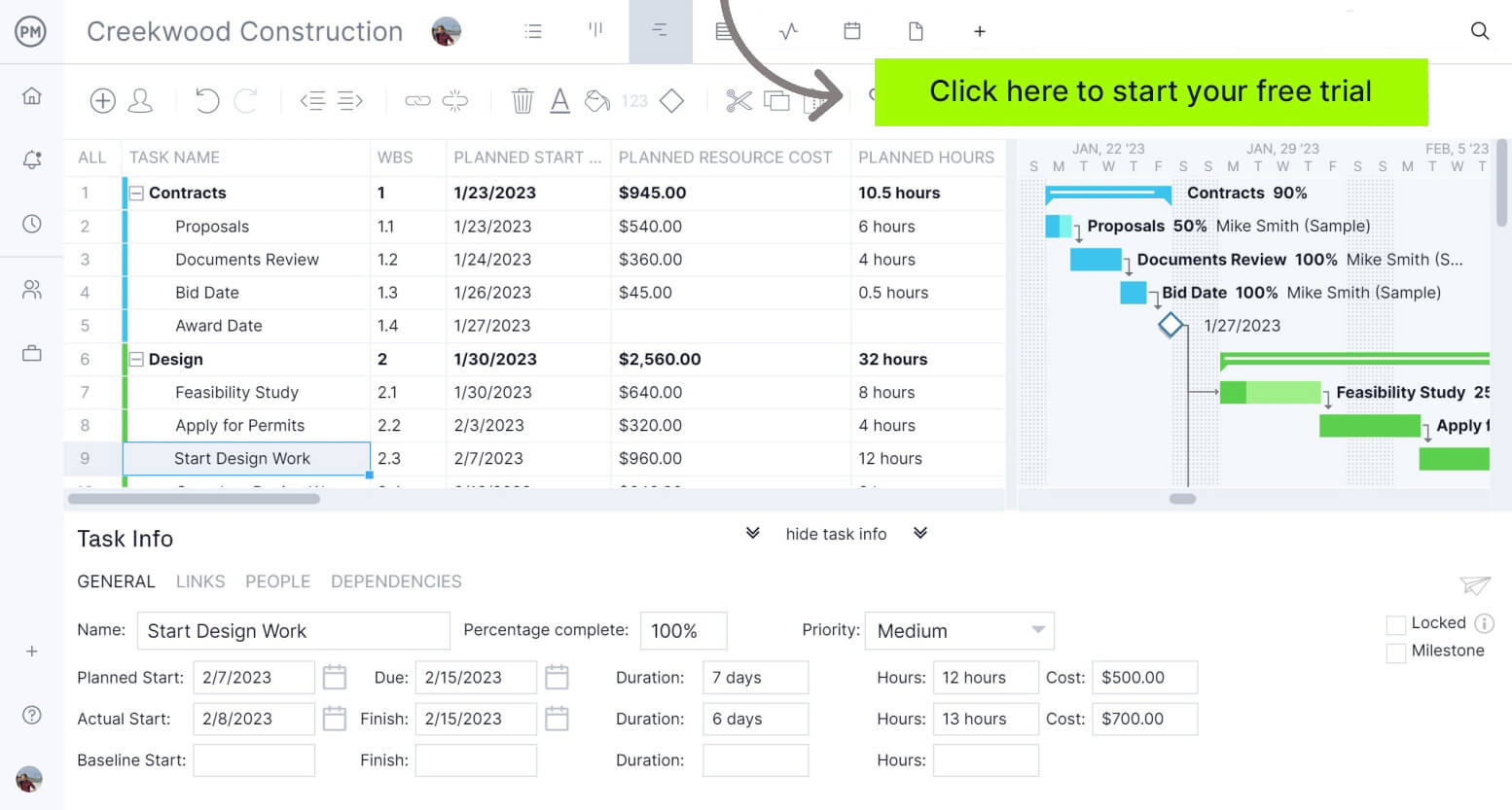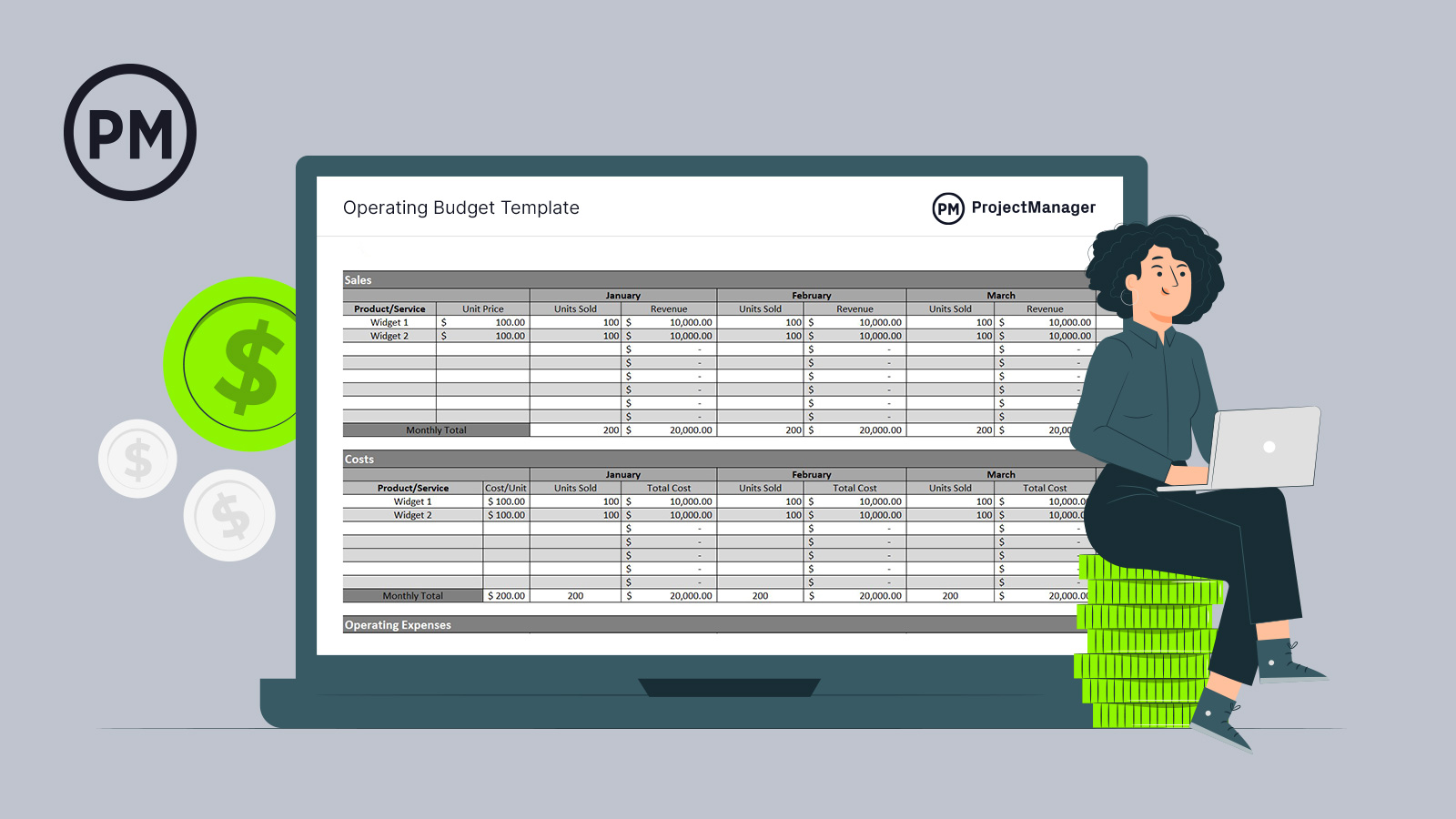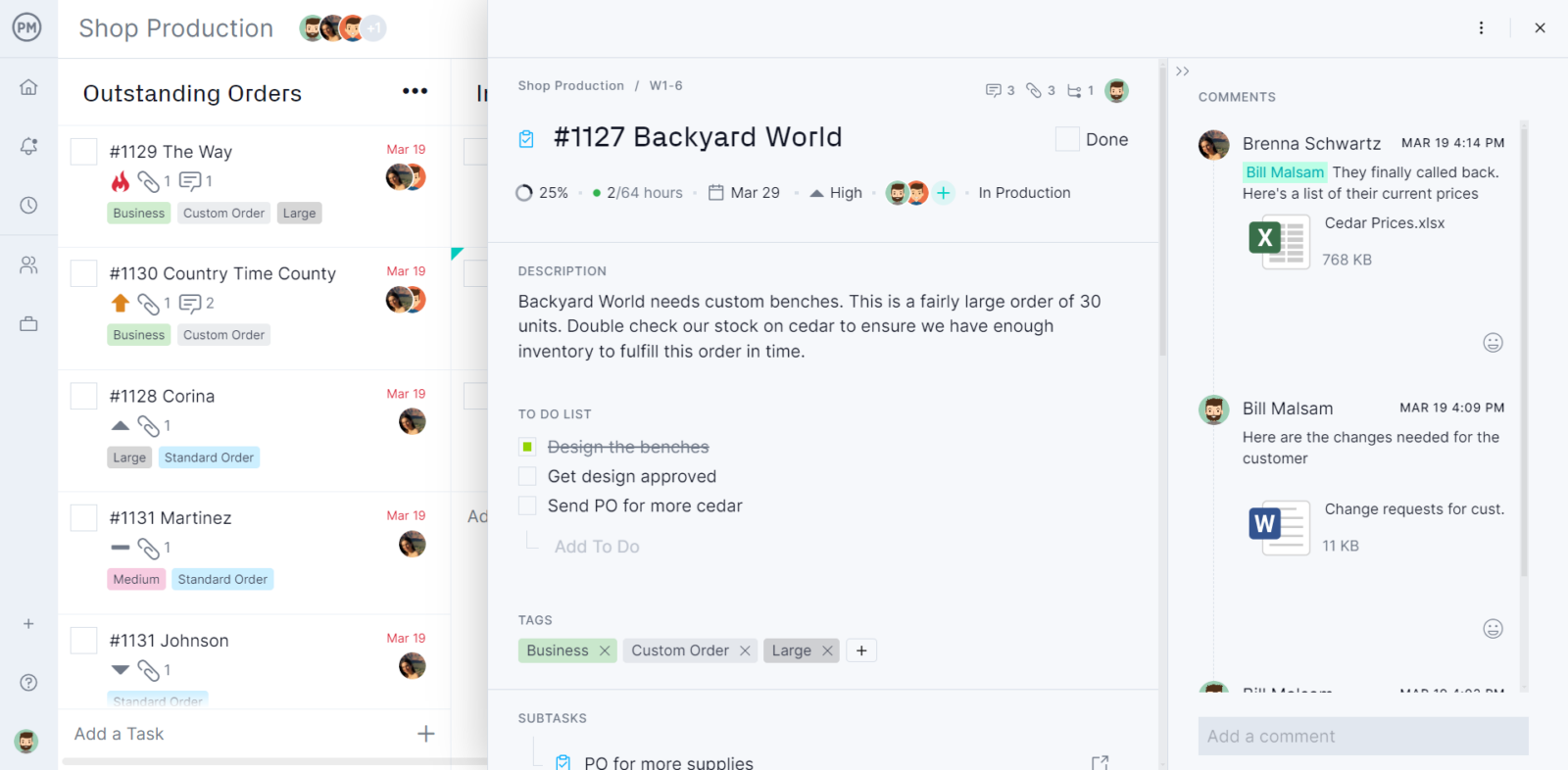The bottom line is often emphasized when discussing how to keep a business solvent. However, focusing only on money disregards the business processes that allow it to operate and contribute to profits. Operational efficiency is another way to look at work when delivering a service or product, particularly popular in manufacturing.
What is operational efficiency and how can you measure it to take advantage of its benefits? Let’s start with the definition and explore how to improve operational efficiency and how project management software can help organizations improve their operational business processes.
What Is Operational Efficiency?
Operational efficiency is a metric used to measure the ratio between the necessary input to keep the company going and the output it provides. Input includes your operational budget, operational costs, employees and time, and output is what’s gained such as rapid development times, quality, revenue, customer acquisition and retention.
Companies use this metric to reduce wasted time, effort and/or materials. This is executed by streamlining operations to work more cost-effectively. Redundant processes are eliminated as is any waste found in the processes. To achieve these goals, companies look at resource utilization, production, inventory management and distribution.
Resource utilization seeks to reduce waste in operations. Optimizing business processes and making sure both your employees and the equipment they’re using are working efficiently is the best way to increase operational efficiency. Regarding distribution, efficiently handling end products such as routing and delivery can make a big difference. Inventory management strives to produce and manage inventory to meet demand but not exceed it to avoid costly warehousing.
Operational efficiency improves with project management software. ProjectManager is online project management software that streamlines processes with multiple work management tools such as Gantt charts, kanban boards, task lists and much more. You can also allocate resources, monitor their utilization and track costs with real-time dashboards and reports. Get started with ProjectManager today for free.

How to Measure Operational Efficiency
Operational efficiency is a great performance indicator, as it helps organizations find ways to lower their costs while maintaining or increasing their profits.
The most popular methods to measure it are the operational efficiency formula and the operating efficiency ratio, but other metrics help organizations get more insight into how resources are being utilized and their outputs.
Operational Efficiency Formula
As noted, the formula for operational efficiency is straightforward. You simply add the operating expenses in the company and then divide that sum by your total revenue.
Operating Expenses / Total Revenue = Operational Efficiency
Taking a hypothetical company, let’s call it Acme Widgets. Say its operating expenses are $100,000 and the company generated annual revenue of $1 million. In this operational efficiency example, the operational efficiency is 0.1.
Operational Efficiency Ratio
The operational efficiency ratio is the same as taking our operational example above and turning it into a percentage. This can be quickly calculated by dividing operating expenses by the total review and then multiplying that sum by 100.
Operating Expenses / Total Revenue * 100 = Operational Efficiency Ratio
For our operational efficiency example, the operational efficiency ratio would be 10 or 10 percent. This operational efficiency example shows how you can make the same or more revenue more cost-effectively by reducing your operational efficiency rate.
The lower the operational efficiency rate, the higher the company’s operational efficiency. Let’s go over other metrics that can be used to assess the operating efficiency of a business.
Operational Efficiency vs. Operational Effectiveness
While they have similar names, operational efficiency isn’t the same as operational effectiveness. Operational efficiency measures the relationship between the input and output of the operations of an organization in terms of costs and revenue, while operational effectiveness evaluates how well the operations of an organization are aligned with its strategic planning goals and objectives.

Get your free
Operating Budget Template
Use this free Operating Budget Template for Excel to manage your projects better.
Operational Efficiency Metrics
While the formulas above help get a general idea of the operational efficiency of an organization, they’re just a basic measurement.
Organizations need to track metrics on operational efficiencies to understand the many factors that affect it, such as their resource utilization rate, revenue generated by their human and capital assets, or the profitability margin of their operations.
- Cost of Goods Sold (COGS): Also referred to as direct operational costs, these are all the direct costs of materials and labor incurred by an organization to make a product or service.
- Operating Expenses: Expenses related to activities that support the current operations of an organization, such as employee wages and selling, general and administrative expenses (SG&A).
- Revenue per Employee: This metric compares an organization’s revenue against its total number of employees. The higher the revenue per employee, the more profitable the operations are from a workforce planning standpoint.
Revenue per employee = Total revenue / Number of full-time employee equivalents
- Return on Assets (ROA): A high return on assets indicates that business operations are generating enough revenue to maintain its capital assets and related costs. If this isn’t the case, keeping those assets might not be profitable.
ROA = Net operating income / Average value of total assets
- Gross Profit: This metric helps organizations with their overall profitability by calculating the percentage of income or revenue that’s left after paying the costs of goods sold.
Gross Profit = Revenue – COGS
- Gross Profit Margin: The gross profit can also be shown as a percentage, known as gross profit margin.
Gross Margin = Revenue – COGS / Revenue * 100
- Operating Profit: Also referred to as earnings before interest & taxes (EBIT) or simply operating income, this operational efficiency metric is the net income of the business operations, which is calculated by subtracting operational expenses, COGS, depreciation and amortization costs from its total revenue.
Operating Profit or EBIT = Revenue – COGS – Operating expenses
Alternatively, this formula can also be expressed as:
Operating Profit or EBIT = Gross Profit – Operating expenses
- Operating Margin: The operating profit can also be shown as a percentage known as the operating margin.
Operating Margin = Operating Profit / Revenue
- Capacity Utilization Rate: To improve operational efficiency, organizations must monitor resource utilization to ensure they use as much of their available capacity as possible.
Capacity Utilization = (Utilized capacity / Total capacity available) * 100
These are just some examples of operational efficiency metrics, but there are many others, including industry-specific measurements for operating efficiency in construction and manufacturing.
Now let’s learn how to improve the operational effectiveness of an organization.
What Is Operational Improvement?
Operational improvement is the process of increasing the operational efficiency of an organization by auditing each of the business processes that make up its operations to make them faster, cheaper, and more productive.
There are many approaches to operational improvement such as Six Sigma, lean, kaizen and value stream mapping, among others. While each of these methodologies is different, most seek to minimize costs and streamline processes by eliminating cost-generating activities that don’t add value to the final customer, known as waste.
However, operational improvement doesn’t necessarily require implementing any of these business process improvement methodologies. Instead, it can be achieved through simple actions and decisions. Let’s learn how this works with two operational efficiency examples.
Operational Efficiency Examples
There are two main things that an organization can do to improve its operational efficiency; reducing its operational costs or increasing its revenue.
Improving Operational Efficiency By Reducing Operating Expenses
Imagine a retail business facing a significant reduction in operational efficiency, due to a significant decrease in revenue over the last year. Now, it needs to take actions to reduce its operating expenses or its profitability and long-term business continuity might be affected. Some of these actions can be:
- Cutting down its workforce on areas that won’t affect its ability to operate
- Reducing the production costs of its products by using alternative materials
- Switching from a brick-and-mortar business model to an online or omnichannel retail model to cut operating costs and potentially increase revenue
- Moving to a new location with lower rent and logistics costs
- Outsourcing business processes such as accounting, marketing, IT or sales
- Optimizing resource capacity utilization to increase the revenue generated by its organizational resources while keeping the current operating costs
Improving Operational Efficiency By Increasing Revenue
The operational efficiency of a business might also be positively affected by an increase in revenue. For example, a manufacturer might discover that the customer demand for its products has increased for the upcoming quarter according to its sales forecasts.
However, this expected customer demand won’t exceed the current production capacity of the organization, which means it won’t need to invest financial resources in expanding its workforce or purchasing machinery.
This will result in increased revenue at no additional operating costs, which means there’s an overall improvement in operational efficiency.
Operations Management Templates
We’ve created dozens of templates that can help manage work, costs, timelines and other aspects of the operations of an organization.
Standard Operating Procedure (SOP) Template
This free standard operating procedure template helps define the guidelines for the operational activities of an organization, which help ensure quality, safety, control resource utilization and more.
Operating Budget Template
Use this free template to define the financial resources that are available for the execution of operational processes, control operating costs and track operational efficiency.
Operational Plan Template
An operational plan defines how a business or nonprofit will operate in the future. It includes business process maps, operating budgets and standard operating procedures, among other key elements.

How to Improve Operational Efficiency
It makes sense that operational efficiency should be top of mind, especially for executives. It’s a more controllable way to deliver profits but as we said, it’s easier said than done. The equation is simple, but developing an operational efficiency strategy is more complicated than basic mathematics.
Here’s a quick overview of some of the strategies that can be utilized to improve operational efficiency.
1. Identify and Map Business Processes
The most important start to any operational efficiency strategy is knowing your operation. You can’t improve what you don’t know. Business process mapping helps identify every business process that makes up the organization’s operations. Then, you can measure the efficiency of each of these processes separately. Use performance metrics analysis and audits to further your understanding of operations and where there is waste and room to improve.
2. Streamline Business Processes
After auditing the business processes that allow an organization to operate, it’s important to take actions to improve them. It’s important to standardize them, minimize their costs, make them faster and increase their output.
3. Focus on Generating Value for Customers and Eliminating Waste
As stated above, waste refers to any operational activity that doesn’t generate any value for a customer. In simple terms, this work won’t help generate revenue but will still cost money. Businesses need to identify such tasks and eliminate them.
4. Communicate With Employees
Operational efficiency is boosted by sharing critical information with your employees and getting feedback from them, which is an important factor in operational improvement methodologies such as lean or kaizen, as their first-hand experience is valuable when determining how to make operations more efficient.
Also, by keeping everyone on the same page, organizations can be more nimble and quickly respond to market changes or any external forces. That only happens when everyone is working on current and accurate data. Streamline communication both externally with customers but also internally between departments.
5. Emphasize Employee Training
Naturally, training is important to ensure your workforce is up to speed with the latest technology in your market. Keeping your employees well-trained on processes and systems means that they’ll work these processes and systems better.
6. Establish a Continuous Improvement Corporate Culture
There’s also a business philosophy of continuous improvement, which never is content with the status quo and is constantly striving to reduce waste. This should be embraced by your company. That means always being on the lookout for improvements across the company, small and large. A little change can have a big impact on quality, cost and production times.
7. Factor in Your Financial Strategy
Of course, the financial strategy must be part of operational efficiency. You can audit cost centers, list all expenses associated with producing your product, and do a root cause analysis. To maintain a good and consistent margin for your company, invest in shorter-term projects (less administrative work, less planning and lower financial commitment). Avoid low-margin work as best you can.
Related: Free Project Report Templates
8. Establish Key Performance Indicators (KPIs)
No matter your operational efficiency strategy, you want to always measure performance. That means defining monitoring and tracking as many metrics and KPIs as you can to get a full picture of how you’re doing and where you can do better.
If you can do this automatically and in real time, the better. However, any performance measurement will go a long way in helping you achieve operational efficiency.
ProjectManager & Operational Efficiency
Being able to leverage technology is going to help you collect more accurate data, which in turn helps improve your operational efficiency. ProjectManager is project management software that delivers real-time data for more insightful decisions when seeking operational efficiency. We have the tools to streamline your communications and help you better monitor and track performance, all in real time.
Connect Everyone in Real Time
Manufacturing involves coordinating different departments in your company with suppliers and outside vendors. Our online software means everyone is connected no matter where or when they work. We have unlimited file storage that makes our tool your central hub for invoices, quotes and more. These files allow for sharing, commenting and reflecting updates to the production schedule. Any updates made to tasks instantly trigger email notifications and in-app alerts so you don’t have to search through emails. Everything you need is in the tool.

Track Performance With Dashboards and Reports
You can’t improve if you don’t know where you are, but you also need to collect current data. Our real-time dashboards automatically collect and calculate live data and display metrics in easy-to-read graphs and charts. This high-level view allows you to find waste and apply improvements where needed. Unlike inferior dashboards, ours requires no setup. There are also customizable reports to pull more details when you need to take a closer look at the time, cost, tasks and more. Reports can be generated with a click and easily shared with executives.

Not everyone in the company will use the same tools which is why we have multiple project views. What’s the point of connecting departments if they can’t work how they want? Best of all, our automated workflows are available on every project view, which improves your operational efficiency from the get-go. No matter what goods or services you provide, we can help you do it more efficiently and differentiate yourself from the competition.
Related Operations Management Content
- Operational Planning: How to Make an Operations Plan
- Operational Strategy: A Quick Guide
- Operations Management: Key Functions, Roles and Skills
- Using Operational Excellence to Be More Productive
ProjectManager is award-winning software that helps improve efficiencies through better collaboration and real-time monitoring and tracking of performance. We have features that help you plan, manage resources and more. Join teams from NASA, Siemens and Nestle who use our software to gain operational efficiency. Get started with ProjectManager today for free.

